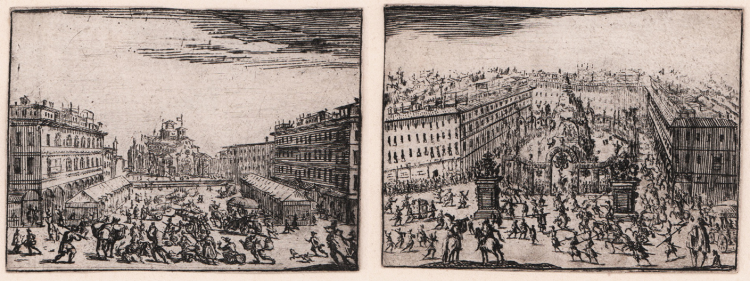





| Reference: | S5300 |
| Author | Melchiorre GHERARDINI |
| Year: | 1631 |
| Measures: | 73 x 55 mm |




| Reference: | S5300 |
| Author | Melchiorre GHERARDINI |
| Year: | 1631 |
| Measures: | 73 x 55 mm |
Etchings, 1631, without the artist’s signature and printing details. From the “Capricci di Varie Figure”, a very rare set made in the style of Jacques Callot.
The first plate (Bartch 49) represents a square with the Duomo (the cathedral of Milan) the construction phase in the background. The scenography of the second plate (Bartch 48) is very interesting. “The machine of Mount Etna” was made for the birthday celebrations of the Prince Baldassarre, the eldest son of the King of Spain. The mountain top was full of flowers and medals, representing the different provinces of Spain. This scenography was a coproduction by the architect Richini, painters Genovesino and Nuvolone and sculptors Prevosto e Lasagna.
Melchiorre Gherardini known as Il Ceranino (Milan, 1607 - 1668) was a painter and engraver. His artistic career is strongly linked to the figure of Giovan Battista Crespi, known as Cerano, whose pupil he not only became but also son-in-law, marrying his daughter Camilla, also a painter. After his death he inherited his workshop and home, where he turns out to have lived with his wife since 1633, the year in which he also adopted his nickname, Ceranino, strongly desired by the painter in order to celebrate the memory of the great protagonist of the seventeenth century and the Milanese Borromean tradition. During his artistic "maturation" he departed from dramatic fantasy to embrace more coruscating compositions embellished with elegant figures tending toward reddish-brown color. He died in 1668, after an intense artistic production with a mainly religious character, which reproposed Ceranesque schemes, enhancing the more scenographic part.
“L'attività di incisore del Gherardini è attestata fin dal 1630, a parte il dubbio Ritratto di Federico Borromeo, dalla serie di cinquanta stampe dei Capricci di varie figure: evidenti i rapporti, ai limiti del plagio, con J. Callot e S. Della Bella, ma anche l'eccentrica vivacità di queste figurine. Una serie di quattordici incisioni, note dagli esemplari della Pinacoteca Tosio Martinengo di Brescia, è preceduta da una dedica del 1636 a un cardinale principe, probabilmente Teodoro Trivulzio, all'apice della fama milanese. Le incisioni appaiono disomogenee con l'alternare soggetti bellici alla peste e al Convito del cardinale-infante, e rispondono probabilmente a un piano politico preciso dopo l'occupazione di Nördlingen da parte dell'esercito imperiale. S'inseriscono in quest'ottica le incisioni con l'Ingresso del cardinale-infante (1633) e le Feste per l'elezione di Ferdinando III (1637), ed è forse coevo il Corso di carrozze al Castello. In parallelo si pone la produzione per il cardinale Cesare Monti, arcivescovo di Milano, dall'Ingresso del 1635 ai Funerali del 1650, probabilmente autografi. Al nipote dell'arcivescovo, Giacomo Simonetta, è dedicato fin dal 1632 un Ritratto del Cerano, derivato dall'effigie realizzata dal Gherardini per i funerali del Cerano nel santuario dei Miracoli. L'attività di incisore di frontespizi è attestata dalla quarta decade della Storia milanese di Giuseppe Ripamonti, edita nel 1643 (cfr. Andrea Spiriti, Gherardini Melchiorre, detto il Ceranino, in “Dizionario Biografico degli Italiani” vol. 53, 2000).
Superb impressions of the only state, showing very good contrasts, printed on contemporary laid paper, trimmed just on the platemark, in perfect conditions.
Provenance: William Roscoe (Lugt 2645)
Bibliografia
Bartsch, Le Blanc nn. 48 -49.
Melchiorre GHERARDINI (Milano 1607 - 1668)
|
Melchiorre Gherardini, known as Ceranino, was an Italian painter. Born in Milan in 1607, Gherardini was closely linked in his artistic career to Giovan Battista Crespi, known as Cerano, his master and father-in-law. On Cerano’s death, he inherited his workshop and house, where he is documented as resident with his wife from 1633 on. This was also the year when he adopted the byname Ceranino in order to celebrate the memory of the great figure of 17th-century painting and the Milanese Borromeo tradition. He died in 1668 after producing a vast amount of work of a primarily religious character based on the models of Cerano with a particular focus of the theatrical elements.
|
Melchiorre GHERARDINI (Milano 1607 - 1668)
|
Melchiorre Gherardini, known as Ceranino, was an Italian painter. Born in Milan in 1607, Gherardini was closely linked in his artistic career to Giovan Battista Crespi, known as Cerano, his master and father-in-law. On Cerano’s death, he inherited his workshop and house, where he is documented as resident with his wife from 1633 on. This was also the year when he adopted the byname Ceranino in order to celebrate the memory of the great figure of 17th-century painting and the Milanese Borromeo tradition. He died in 1668 after producing a vast amount of work of a primarily religious character based on the models of Cerano with a particular focus of the theatrical elements.
|